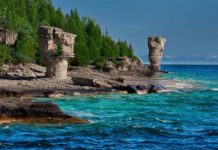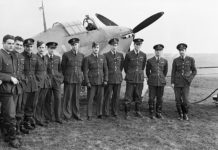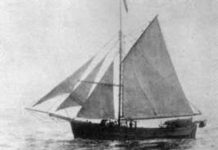From its founding in 1604, New France’s survival depended on the profitability of the fur trade, specifically beaver pelts. Samuel de Champlain, the colony’s first deputy viceroy and founder of the settlement at Quebec, was keenly aware of this critical dependency and of the need to establish and maintain good relations with the native peoples (particularly the Huron, Algonquin, and Montagnais nations) who exchanged furs for European goods. To this end, Champlain sent representatives to the tribes’ villages. These young men, known as truchements (interpreters) were directed to live among the Indians in order to learn their languages and understand their customs. Additionally, they were to study the geography of the surrounding countryside and make maps for future reference.
Etienne Brule became Champlain’s first truchement. Rash, entrepreneurial and daring, he was the first white man to see much of the North American interior and deserves to be ranked as one of the continent’s foremost explorers. However, his legacy was ultimately overshadowed by an act of treachery.
Background and Initial Explorations
Brule had arrived in New France in 1608, aged sixteen, as Champlain’s engage (indentured servant). He was a member of the party that founded Quebec later in the same year, and endured the horrific winter of 1608-09 that killed most of the group. His fortitude and physical strength, combined with a lively intellect and exceptional initiative, quickly made him a favourite of Champlain.
In the summer of 1610, Brule eagerly acceded to Champlain’s request to live among the Algonquin people and learn their language. During the next twelve months, Brule travelled throughout the tribe’s territory, which lay on the south side of the Ottawa River within the triangle formed by the site of present-day Ottawa, Lac des Deux-Montagnes (the confluence of the Ottawa and St. Lawrence rivers) and the eastern tip of Lake Ontario. He mastered the Algonquins’ language and that of their Huron allies, and also began to adopt the Indians’ way of life: when reunited with Champlain in June 2011, he was dressed entirely in native clothing.
Delighted with the results of Brule’s initial assignment, Champlain then sent him to Huronia, homeland of the Huron nation, the territory bounded by Georgian Bay and the Severn River to the North, Lakes Simcoe and Couchiching to the east,, Lake Huron to the west, and Lakes Ontario and Erie to the south. Brule was the first white man to travel the waterway to the Hurons’ country, ascending the Ottawa River to its juncture with the Mattawa River, then following the Mattawa’s course to Lake Nipissing and continuing west to the French River. For the next four years, Brule explored Huronia and beyond. In one expedition, accompanied by several Hurons, he journeyed up the western shore of Georgian Bay to its northern extremity, and then followed its Inner Channel west to the mer douce, Lake Huron. Continuing westward, the company traced the northern shore of Lake Huron to its junture with another grand lac, Lake Superior, at the great rapids of Sault Ste. Marie.
Brule also studied the Hurons’ involvement in the fur trade. Upon his return to Quebec in 1615, he was able to provide Champlain (now Governor of New France) with details of the trade’s organization and the Hurons’ pivotal role as middlemen for all the tribes within hundreds of miles of Huronia.
Brule’s Disappearance
In the autumn of 1615, Champlain agreed to join the Hurons and their allies, the Andastes, in an assault on the main village of the Onondaga people, one of the Five Nations of the Iroquois Confederacy. He sent Brule and a Huron escort to the Andastes’ homeland on the upper reaches of the Susquehanna River to ensure they rendezvoused with the Hurons on schedule. However, the Andastes stalled for several days and reached the Onondaga village too late: the Hurons had abandoned the fight and fled home. Rather than returning to Huronia or Quebec, Brule and his escort accompanied the Andastes back to their village, and wintered there. In the spring, they launched their canoes and spent the next two years roving, with no apparent purpose other than satisfying Brule’s wanderlust. Brule kept no written record of these travels and made no maps, but his verbal accounts suggested he and the Hurons journeyed through an immense territory. Initially, they paddled down the Susquehanna River to Chesapeake Bay, which they followed south to the Potomac River. They likely travelled up the Potomac for some distance, then continued northwest on a track that would have brought them to the Ohio River. At some point thereafter they turned north and eventually reached the shores of Lake Superior (it’s unclear whether their route included Lake Michigan). Finally they headed southeast, making for Huronia, but were attacked by Iroquois raiders en route. Brule was saved by his unfailing ability to ingratiate himself to native peoples: the Iroquois befriended him and facilitated his safe passage to Huronia. There, in the summer of 1618, he joined a fur flotilla bound for Quebec.
Upon reaching the colony, Brule (who Champlain had believed dead) carefully avoided his mentor – possibly because he had failed to compile a written record of his unauthorized travels or to make any maps that would aid future exploration. Also, he had decided to quit Quebec for good and live among the Hurons, a decision he communicated to the Governor when finally compelled to appear before him. While the two men parted amiably, they would meet again eleven years later in very different circumstances.
Treachery
Brule returned to Huronia and became active in the fur trade. He also underwent a marked personality change. His friend, the Recollet priest Gabriel Sagard, lamented that Brule – always quick to anger – had become “vicious” and also “addicted to women”, taking native women as wives wherever he went and discarding them as he pleased.
Between 1622 and 1628, Brule travelled to France several times (he married a French woman in 1626), but the lure of the North American wilderness always drew him back. In 1628, while returning to New France, he was captured by the English and taken to London: there, he agreed to aid his captors in their efforts to seize Quebec. Brule provided detailed information on the settlement’s defenses and fortifications, and was one of four French turncoats who guided the English battle fleet up the St. Lawrence to capture Quebec on 19 July 1629. After capitulating, Champlain learned he had been betrayed by Frenchmen. Permitted to confront the traitors, he immediately recognized his former protege among them. Champlain berated the four heatedly, and was in no way placated by Brule’s retort that he had done no harm because Quebec could not have withstood an English assault in any event.
Final Years
Retreating to Huronia, Brule lived a debauched and idle existence at the village of Toanche on Penetanguishene Bay. In 1633 the Hurons, tired of his amoral behaviour and treachery, demanded that he leave their country. By then, however, the French had regained their North American colonies, Champlain was back at Quebec, and Brule faced execution there and in France.The man whose only loyalty was to himself had no place to go.
Reluctantly, the Hurons decided on drastic measures: a group of warriors attacked Brule and beat him to death. His body was butchered, boiled in a kettle, and consumed in a communal meal. Brule, the first Frenchman to be completely assimilated by the Hurons, is believed to be the only one ever killed by them.
Sources:
- Costain, Thomas B. The White and the Gold: The French Regime in Canada. Doubleday & Company, Inc., Garden City, New York, 1954.
- Eccles, William J. The Canadian Frontier: 1534 – 1760. Holt, Rinehart & Winston Inc., Toronto, 1969.
- Fischer, David Hackett. Champlain’s Dream. Alfred A. Knopf Canada, 2008.
- Hayes, John F. Wilderness Mission. The Ryerson Press, Toronto, 1969.
- Hunter, Douglas. God’s Mercies. Doubleday Canada, 2007.
- Winsor, Justin. Cartier to Frontenac: Geographical Discovery in the Interior of North America in its Historical Relations 1534 – 1700. Cooper Square Publishers, New York, 1970. (Reprint of the 1894 edition.)






